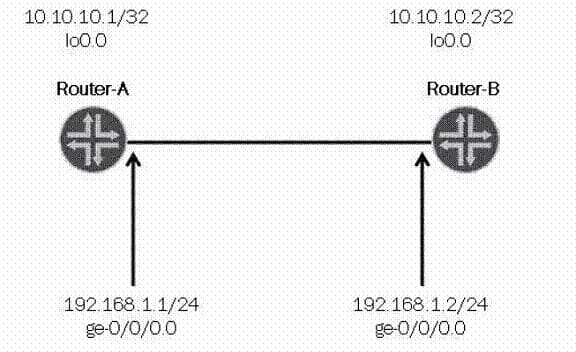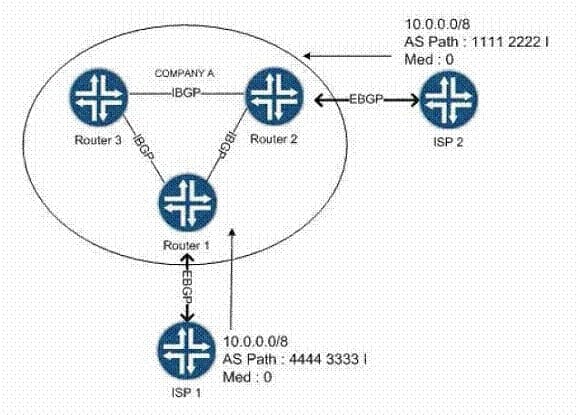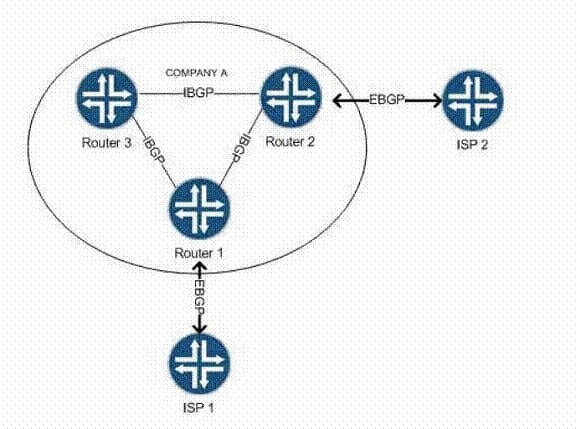Exam Details
Exam Code
:JN0-343Exam Name
:Juniper Networks Certified Internet Specialist (JNCIS-ENT)Certification
:Juniper CertificationsVendor
:JuniperTotal Questions
:563 Q&AsLast Updated
:Jun 12, 2025
Juniper Juniper Certifications JN0-343 Questions & Answers
-
Question 301:

Router-A and Router-B shown in the exhibit are peering between their loopback interfaces. Which operational-mode command on Router-B do you use to display the BGP routes advertised to Router-A?
A. show route advertising-protocol bgp 10.10.10.2
B. show route advertising-protocol bgp 10.10.10.1
C. show bgp rib-out neighbor 10.10.10.1
D. show bgp neighbor 10.10.10.1 advertised-routes
-
Question 302:
ESTION NO: 249
You must create an IP-IP tunnel between two routers on your network. These two devices are separated by 10 hops. The tunnel appears to be established, but no traffic is traversing the tunnel. What causes this behavior?
A. The tunnel's TTL has not been modified from the default value of 8.
B. Traffic is being dropped along the path because a configured MTU is greater than the tunnel's MTU.
C. A route that directs traffic into the tunnel is not present.
D. BGP has not been enabled between tunnel end-points.
-
Question 303:

Router 2 is receiving two announcements of a route to 10.0.0.0/8. Router 2 learned one version of the route from ISP-2; this announcement of the route was received first. The second announcement of the route was received from Router 1 using IBGP. What will Router 2 do with the routes shown in the exhibit?
A. Router 2 will choose to forward traffic toward ISP 2 because this route was learned first.
B. Router 2 will choose to forward traffic toward Router 1 because newer routes are preferable.
C. Router 2 will choose to forward traffic toward ISP 2 because EBGP-learned routes are preferred over IBGP-learned routes.
D. Router 2 will choose to forward traffic toward Router 1 because IBGP-learned routes are preferred over EBGP-learned routes.
-
Question 304:
Which three types of firewall filters are supported by Juniper Networks EX Series Ethernet switches? (Choose three.)
A. a VLAN-based firewall filter applied to Layer 3 in the ingress and egress directions
B. a router-based firewall filter applied to Layer 2 routed interfaces in the ingress and egress directions
C. a router-based firewall filter applied to Layer 3 routed interfaces in the ingress and egress directions
D. a port-based firewall applied to Layer 2 switch ports in the ingress and egress direction
E. a VLAN-based firewall applied to Layer 2 VLANs in the ingress and egress directions
-
Question 305:
Which three statements are true of GRE tunnels? (Choose three.)
A. The local tunnel endpoint must have a valid route to the remote endpoint.
B. GRE tunnels must authenticate at both ends of the tunnel.
C. Tunnel endpoints must have a route that directs traffic into a tunnel.
D. The "gr" interface can only route packets that are IP protocol packets.
E. All intermediary devices must have a route to the tunnel endpoints.
-
Question 306:
You add a GRE tunnel to transport packets between two routers. After implementing this, you notice an increase in the number of dropped packets. While looking at packet captures, you notice that the do-not-fragment (DF) bit is set in the IP header of all the dropped packets.
What would cause this changed behavior?
A. The GRE tunnel has a lower MTU than the physical interface.
B. GRE tunnels do not support fragmentation.
C. GRE tunnels do not support the DF bit.
D. The GRE tunnel has a higher MTU than the physical interface.
-
Question 307:
Your customer wants to connect a VoIP phone to interface ge-0/0/5 on an EX4200 switch in VLAN 20 and connect a PC to the VoIP phone. The PC should be part of VLAN 30.
Which two commands will implement this solution? (Choose two.)
A. set interface ge-0/0/5.0 family ethernet-switching vlan members vlan-30
B. set ethernet-switching-options voip interface ge-0/0/5.0 vlan 20
C. set interface ge-0/0/5.0 family ethernet-switching vlan members vlan-20
D. set ethernet-switching-options voip interface ge-0/0/5.0 vlan 30
-
Question 308:
Which two statements describe STP and RSTP interoperability? (Choose two.)
A. STP protocol discards any RSTP BPDUs it receives.
B. STP protocol accepts RSTP BPDUs but will not respond.
C. RSTP accepts STP BPDUs and responds with STP BPDUs.
D. RSTP discards STP BPDUs.
-
Question 309:
How do two BGP peers signal their capabilities to each other?
A. They include their capabilities in OPEN messages.
B. They send UPDATE messages with their capabilities after the session is established.
C. They send CAPABILITIES messages before they send OPEN messages.
D. The network operator must manually configure the capabilities on both BGP peers.
-
Question 310:

Company A wants to control how BGP traffic reaches the Internet.
What should you configure to ensure that traffic exits the network by way of Router 1 toward ISP 1?
A. You should change the underlying IGP metric to make Router 1 more preferable.
B. You should configure Router 1 to have a community with an IBGP export policy, which makes its routes more preferable.
C. You should configure Router 1 to have a higher local-preference value with an EBGP import policy to make its routes more preferable.
D. You should set Router 2's MED to a higher value using an IBGP export policy to make its routes less preferable.
Related Exams:
JN0-102
Internet Associate, Junos(JNCIA-Junos)JN0-104
Junos, Associate (JNCIA-Junos)JN0-105
Junos, Associate (JNCIA-Junos)JN0-1101
Juniper Networks Certified Design Associate (JNCDA)JN0-1103
Design, Associate (JNCIA-Design)JN0-130
Juniper networks Certified internet specialist.e(jncis-e)JN0-1301
Data Center Design, Specialist (JNCDS-DC)JN0-1302
Data Center Design Specialist (JNCDS-DC)JN0-1331
Security Design, Specialist (JNCDS-SEC)JN0-1332
Security Design, Specialist (JNCDS-SEC)
Tips on How to Prepare for the Exams
Nowadays, the certification exams become more and more important and required by more and more enterprises when applying for a job. But how to prepare for the exam effectively? How to prepare for the exam in a short time with less efforts? How to get a ideal result and how to find the most reliable resources? Here on Vcedump.com, you will find all the answers. Vcedump.com provide not only Juniper exam questions, answers and explanations but also complete assistance on your exam preparation and certification application. If you are confused on your JN0-343 exam preparations and Juniper certification application, do not hesitate to visit our Vcedump.com to find your solutions here.